This article needs additional citations for verification .(January 2009) |
Smith and Pepper was a jewellery manufacturing firm in Birmingham, England, which traded between 1899 and 1981. The factory is now the Museum of the Jewellery Quarter.
This article needs additional citations for verification .(January 2009) |
Smith and Pepper was a jewellery manufacturing firm in Birmingham, England, which traded between 1899 and 1981. The factory is now the Museum of the Jewellery Quarter.
Mr. Smith and his uncle Mr. Pepper became business partners after Smith had split from his family business. The business was set up in Birmingham in an area known as the Jewellery Quarter in adjoining buildings 78 and 79 Vyse Street. The company became known around the world.
The firm made a wide range of jewellery, notably swallow designs, popular during the World Wars and Egyptian style snake designs, after Egyptologist Howard Carter made ancient Egypt fashionable. It finally stopped trading in 1981, when the three owners decided to retire. For its 82-year history the firm was run as a family business, although by the end it was being run by the Smith family alone.
The doors were closed and locked on a Friday and the building was subsequently sold to the Birmingham City Council. It was several years before the doors were reopened, and the council employees discovered a virtual time capsule of jewellery production, and techniques, as well as more personal work life related items some dating back as far as 1899. [1] [2]
The factory and buildings are now open to the public as the Museum of the Jewellery Quarter which can be found by its website [3] as part of Birmingham Council's Birmingham Museums and Art Galleries site. [4]
The museum includes a guided tour of the actual jewellery factory, showing the tools and industry-related architectural features of the trade.

Birmingham Museum and Art Gallery (BM&AG) is a museum and art gallery in Birmingham, England. It has a collection of international importance covering fine art, ceramics, metalwork, jewellery, natural history, archaeology, ethnography, local history and industrial history.

The Custard Factory is a creative and digital business workspace complex, including independent shops, cafes and bars, on the site of what was the Bird's Custard factory off High Street, Deritend, in the Digbeth area of central Birmingham, England.

Hockley is a central inner-city district in the city of Birmingham, England. It lies about one mile northwest of the city centre, and is served by the Jewellery Quarter station. Birmingham's Jewellery Quarter continues to thrive in Hockley, and much of the original architecture and small artisan workshops have survived intact.

The Big City Plan is a major development plan for the city centre of Birmingham, England.

The Jewellery Quarter is an area of central Birmingham, England, in the north-western area of Birmingham City Centre, with a population of 19,000 in a 1.07-square-kilometre (264-acre) area.

The Gun Quarter is a district of the city of Birmingham, England, which was for many years a centre of the world's gun-manufacturing industry, specialising in the production of military firearms and sporting guns. It is an industrial area to the north of the city centre, bounded by Steelhouse Lane, Shadwell Street and Loveday Street.
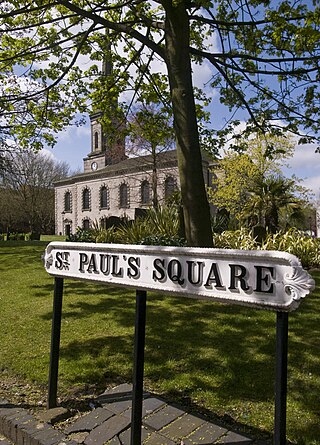
St Paul's Square is a Georgian square in the Jewellery Quarter, Birmingham, England, named after the church in its centre. It is the last remaining Georgian Square in the city.

The Argent Centre is a Grade II* listed building on the corner of Frederick Street and Legge Road in the Jewellery Quarter of Birmingham, England.

1–7 Constitution Hill in Birmingham, England is a Grade II listed building at the acute junction with Hampton Street, and is a former H.B. Sale factory. The red brick and terracotta structure is extremely thin, with a tower at one end.

The Museum of the Jewellery Quarter is a museum at 75-79 Vyse Street in Hockley, Birmingham, England. It is one of the nine museums run by the Birmingham Museums Trust, the largest independent museums trust in the United Kingdom.

The Elkington Silver Electroplating Works was a building on Newhall Street in Birmingham, England. It later housed the Birmingham science museum Museum of Science and Industry until the creation of Thinktank.

Birmingham city centre, also known as Central Birmingham, is the central business district of Birmingham, England. The area was historically in Warwickshire. Following the removal of the Inner Ring Road, the city centre is now defined as being the area within the Middle Ring Road. The city centre is undergoing massive redevelopment with the Big City Plan, which means there are now nine emerging districts and the city centre is approximately five times bigger.
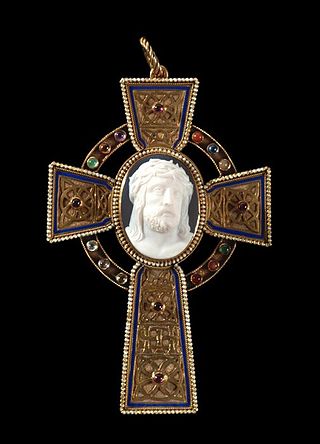
John Brogden was a Victorian-era manufacturing jeweller.

Newman Brothers at The Coffin Works is a museum in the Newman Brothers Coffin Furniture Factory building in the Jewellery Quarter conservation area in Birmingham, England. The museum educates visitors about the social and industrial history of the site, which operated from 1894–1998 as a coffin furniture factory. The museum opened in October 2014 after a fifteen-year campaign by the Birmingham Conservation Trust to save the factory building, which ceased trading in 1998, and raise the funds to transform it into a heritage attraction. Located at 13–15 Fleet Street, the building is Grade II* listed.

James & Lister Lea was an architectural and property consultancy firm active in England between 1846 and 2001.
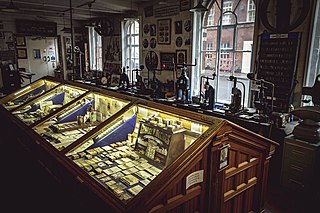
The Pen Museum is a museum in Birmingham, England, covering the history of Birmingham's steel pen trade. The only museum in the United Kingdom devoted to the history of the pen making industry, the Pen Museum explains how Birmingham became the centre of the world pen trade.

Birmingham School of Jewellery, founded in 1890, is a jewellery school in Birmingham, England. Located on Vittoria Street in the city's Jewellery Quarter, it is the largest jewellery school in Europe. It is part of the Arts, Design and Media Faculty (ADM), a faculty of Birmingham City University.
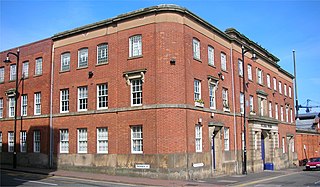
The Victoria Works is a Grade II listed building in the Jewellery Quarter of Birmingham, England. It was built in 1839–40 for Joseph Gillott, who manufactured pen nibs, and was one of the first purpose-built factories in the Jewellery Quarter. It is situated opposite the Argent Centre, another building constructed for industrial use around the same period. The factory was one of the largest of its kind, with nearly 600 workers. Steam engines of 60 horsepower powered the mass production of the nibs.
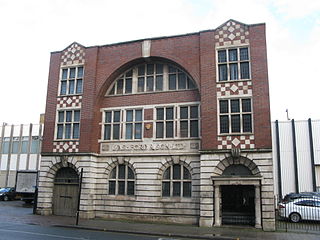
The former Ashford & Sons factory in Birmingham, England is a Grade II* listed building in Arts & Crafts style.
Azza Fahmy is an Egyptian jewellery designer, and the founder of the design house Azza Fahmy Jewellery. Fahmy was the first woman to train in Egypt's jewellery quarter, Khan El Khalili. In 2013 Fahmy founded ‘The Design Studio by Azza Fahmy’, in partnership with Alchimia, Contemporary Design School in Florence.